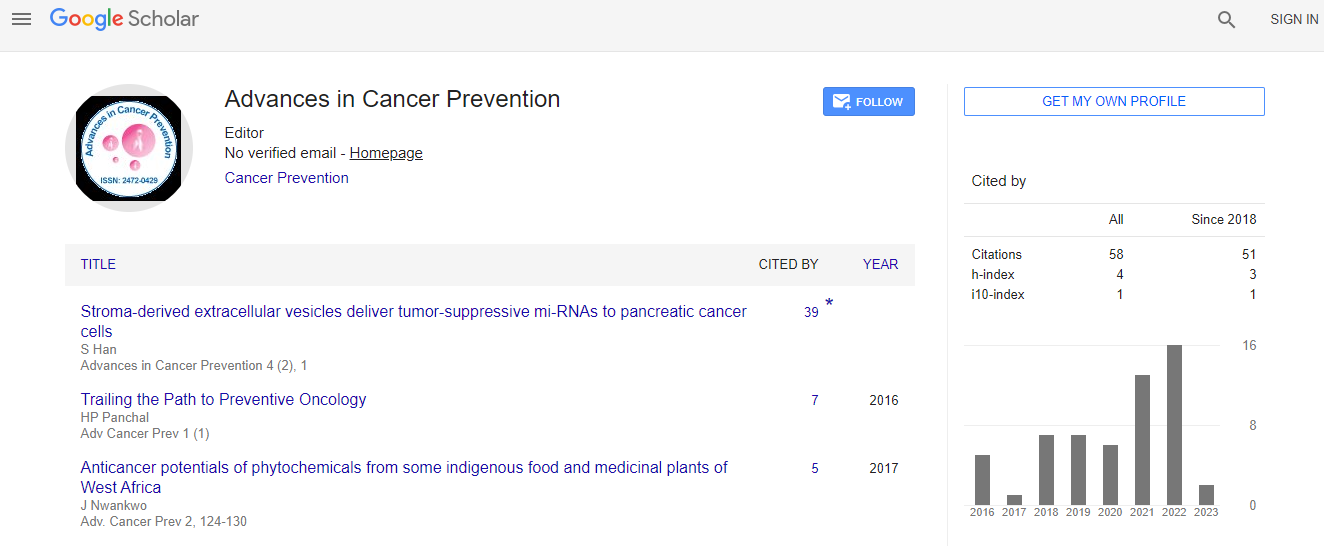Research Article
Expression of Stem Cells Marker ALDH1 in Premalignant Lesions, Cancer, Benign Hyperplasia and Normal Duct of Human Breast
Aiping Shi1*, Xin Guan1, Lu Han1, Yi Dong2, Wenlong Li1, Angela Vantreese3, Lirong Bi1 and Peng Zhao11Department of Breast Surgery, The First Hospital of Jilin University, Changchun, Jilin, China
2Department of the Second Section Office of Breast Tumor, Jilin Cancer Hospital, Changchun, Jilin, China
3Ballare High School, Houston, USA
- *Corresponding Author:
- Aiping Shi
Department of Breast Surgery
The First Hospital of Jilin University
Changchun, Jilin, China
Tel: +008615804301451
E-mail: 13364308696@163.com
Received date: February 02, 2016 Accepted date: March 14, 2016 Published date: March 21, 2016
Citation: Shi A, Guan X, Han L, Dong Y, Li W, et al. (2016) Expression of Stem Cells Marker ALDH1 in Premalignant Lesions, Cancer, Benign Hyperplasia and Normal Duct of Human Breast . Adv Cancer Prev 1:107. doi:10.4172/acp.1000107
Copyright: © 2016 Shi A, et al. This is an open-access article distributed under the terms of the Creative Commons Attribution License, which permits unrestricted use, distribution, and reproduction in any medium, provided the original author and source are credited.
Abstract
Purpose: To study the differences of ALDH1 expression in Invasive Ductal Carcinoma (IDC), Atypical Ductal Hyperplasia (ADH), Usual Ductal Hyperplasia (UDH) and normal ducts and their clinical significance.
Materials and Methods: Immunohistochemistry method was used to detect the expression of ALDH1 in 160 cases of IDC, 50 cases of ADH, 20 cases of UDH and 22 normal duct cases.
Results: ALDH1 was expressed in a few cells in most samples except in a few cases of ADH, UDH and normal ducts, in which ALDH1 expression showed extensive distribution. The positive rate of ALDH1 expression in luminal epithelial cytoplasm of IDC, ADH and UDH was 35%, 64% and 80%, while in myoepithelial cells and stroma of IDC, ADH and UDH was 40%, 52% and 70%. ALDH1 expression in luminal epithelial cytoplasm of IDC has correlation with OS and RFS of the breast cancer patients (P<0.05). However, in myoepithelial cells and the stroma of IDC, no correlation was found in OS and RFS (P>0.05). The chi-square test of ALDH1 expression in luminal epithelial cytoplasm of three kinds of tissues has shown statistical significance (P<0.05). Statistical significance was also found in myoepithelial cells and stroma of three kinds of tissues (P<0.05). We evaluated the semiquantitative expression of ALDH1 using a score based on positive cells rate and staining density in benign lesions. The score of ALDH1 in luminal epithelial cytoplasm expression is 3, 2, and 1 while myoepithelial cells and stroma expression are 3, 2, and 2 in ADH,UDH and normal ducts respectively. ALDH1 expression in either luminal epithelial cytoplasm or in myoepithelial cells and stroma in ADH is higher than that in UDH and normal duct, but there is no significance according to the Kruskal-Wallis rank sum test (P>0.05).
Conclusion: The positive expression of ALDH1 may play a role during the evolution of disease from ADH to breast cancer, as ALDH1 has a predicted value in outcome of breast cancer.

 Spanish
Spanish  Chinese
Chinese  Russian
Russian  German
German  French
French  Japanese
Japanese  Portuguese
Portuguese  Hindi
Hindi 